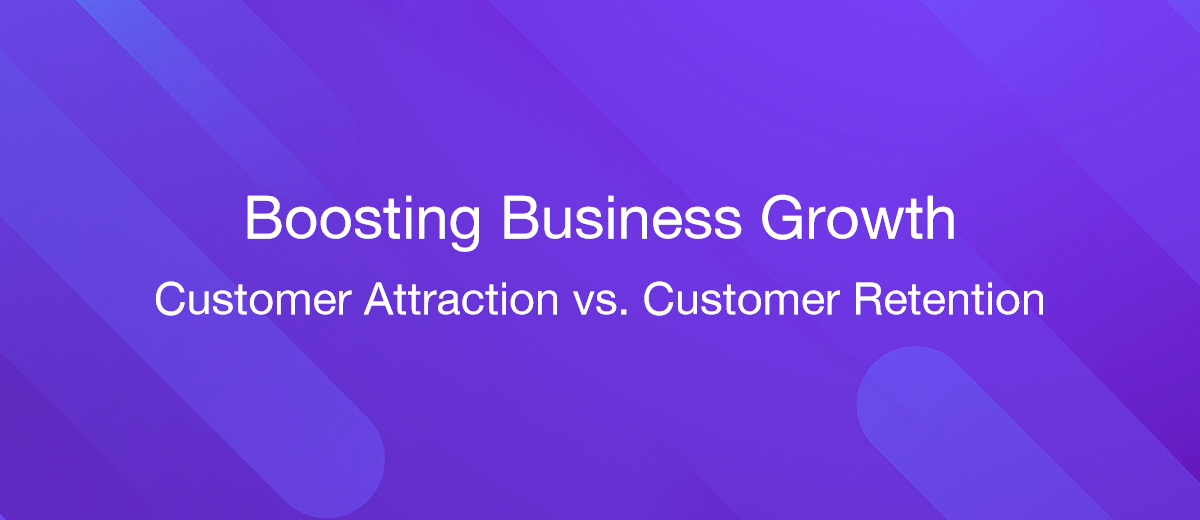Boosting Business Growth: New Customer Attraction vs. Existing Customer Retention
A pivotal question every entrepreneur or business leader faces is the choice between prioritizing the acquisition of new customers or focusing on the retention of existing ones to improve business growth. This dilemma is central to the strategic planning of any business, regardless of its scale or industry. Both strategies are integral to a company's success, and the debate over which one should take precedence is ongoing.
Regardless of whether you're managing a large enterprise or a small retail storefront, the success of your business is significantly influenced by how well you balance drawing in new customers and keeping existing ones loyal. Deciding which strategy to focus on can be challenging, considering each method comes with its own set of advantages and limitations.
What is Client Acquisition?
For almost all companies, the goal is clear-cut – to acquire more business. This is a universal truth, whether the organization offers CAD integration software or sells products online. Attracting a larger customer base leads to an uptick in sales, which is a crucial step towards the growth and expansion of the company.
Different businesses employ various approaches to draw in new clients. The methods can vary widely, from establishing collaborations with other organizations to directly advertising products or services to consumers – it all depends on the specific needs of the business. The primary objective of all these strategies, however, is to unlock new revenue streams, ultimately contributing to the financial well-being of the company.
Revenue generation is vital for covering the operational costs of a business. Recognizing this, many companies place a significant emphasis on client acquisition, dedicating considerable resources to it in order to ensure their survival.
How Does Client Acquisition Help Businesses?

The pursuit of new clients is often regarded as a key catalyst for the growth and success of a business. Here are some notable benefits of prioritizing client acquisition:
Boost in Revenue
Gaining new clients means opening up additional sources of income. Expanding your client base directly increases your revenue potential, providing more funds that can be reinvested to improve your products, services, and overall customer experience.
Edge Over Competitors
A successful client acquisition strategy can give you an edge over your competitors. By attracting a larger customer base, you might also be redirecting potential customers away from your rivals. This strengthens your standing in the market and equips your business to better handle competitive pressures.
Market Diversification
Acquiring new business not only enlarges your customer base but also enhances your earning potential. Reinvesting these additional profits back into your business can lead to improvements in your offerings, and, over time, this diversification contributes to more stable and sustainable growth.
Enhancement of Brand Awareness and Market Presence
Client acquisition is not just about increasing sales – it plays a crucial role in exploring and entering into new markets. By targeting various demographics and customer locations, your business can access untapped market segments and widen its influence. This increased visibility helps in attracting even more potential clients.
What is Client Retention?
Client retention refers to the ability of a company or product to retain its customers over a specified period. High client retention means customers of the product or services of the business stay loyal to the brand. On the other hand, low client retention implies that the company is losing clients over time.
Client retention strategies typically involve providing exceptional customer service, building strong relationships with customers, understanding and meeting their needs, and providing ongoing value.
Effectively nurturing client relationships requires significant resources. Skilled account management teams play a critical role in addressing the daily needs and concerns of clients. It's equally important to budget dedicated resources to ensure continual satisfaction throughout the client's journey with the company.
How Does Client Retention Help Businesses?
While bringing in new clients is a vital part of expanding a business, emphasizing client retention brings its own set of distinct advantages. Here are key reasons why retaining existing customers is crucial:
Stable Revenue Stream
Existing customers typically represent a more stable source of revenue than new ones. They've already established trust in your brand and are more inclined to make repeat purchases. In contrast to new customers who might only buy once, loyal customers usually have recurring needs and a stronger allegiance to your brand. They also contribute to your business through word-of-mouth referrals, attracting potential new customers.
Enhances Business Credibility
Having a base of long-term customers greatly increases your business's credibility. Sustained customer relationships are a powerful case to the quality of your products or services and can help to attract potential new clients. Satisfied customers also frequently share their positive experiences, acting as free word-of-mouth advocates for your brand.
Facilitates Product and Service Innovation
Focusing on client retention often means continuously enhancing and innovating your offerings to meet your customers' changing needs. With a loyal customer base, you have a group of users who are more willing to experiment with your new products and provide insightful feedback. This ongoing process of innovation can lead to the development of better products and services.
Cost-Effective Compared to New Client Acquisition
The cost of acquiring a new client can be up to five times higher than retaining an existing one. Strategies for keeping clients, like enhancing customer service or offering loyalty incentives, typically demand fewer resources than those needed for acquiring new clients, which often involve extensive marketing and promotional efforts.
Striking the Right Balance Between Client Acquisition and Retention
Choosing between prioritizing new client acquisition and nurturing existing ones depends on a variety of factors. However, leaning too heavily in one direction can lead to lost opportunities or a lackluster client base. Finding an optimal balance is crucial, and companies should craft strategies that both attract new clients and deepen existing relationships. Here’s how they can do this:
Focusing on Customer Lifetime Value (CLV)
Assessing the value of a potential customer involves understanding their Customer Lifetime Value (CLV). This metric is crucial for evaluating the financial viability of pursuing a client and their ongoing contribution to the business.


CLV is not fixed - it can change due to various factors. For example, a client's current demand for specific security software or services of Next Generation 911 may evolve over time. Nonetheless, CLV is an essential tool for making informed decisions on which sales leads to pursue.
Balancing CLV against the cost of acquiring new clients allows companies to target their sales efforts more effectively. This strategy ensures resources are allocated towards clients who promise the most long-term profitability.
Strategic Configuration of Sales Teams
The structure of a sales team can differ widely, depending on the company's culture and the sales leader's approach. Some organizations may divide their teams between those focusing on new client acquisition and those managing existing accounts, while others might organize them by geographic regions or industry sectors. The compensation model for sales teams can also unintentionally skew focus towards either new client acquisition or retention.
Understanding the need to balance new customer acquisition with the retention of existing ones is essential. The nature of the target customer base and the company's offerings can influence the organization of the sales team. Aligning sales strategies with broader business goals is fundamental for sustained growth and success.
Emphasizing Accurate Forecasting
Running a business without an accurate sales forecast is problematic. A lack of clear sales objectives and strategies makes it challenging to direct financial efforts effectively.
A comprehensive forecast that covers both projected sales and potential growth areas is key to deciding how to spend company resources and focus. It's important to note that predictions based on potential new revenue streams are often less reliable than those based on established contracts.
Incorporating a margin of error in revenue forecasts can cushion against unexpected economic changes, avoiding constant recovery from missed opportunities and ensuring smoother operations. A balanced and cautiously optimistic forecast allows for more confident and less risky business management.
Achieving Optimal Business Results Through Acquisition and Retention
The decision between focusing on new client acquisition or nurturing existing customer relationships varies for each business. It’s important to recognize that while attracting new clients often requires more resources and effort, maintaining current relationships is equally vital. Effective balance in both business development and account management is key to this strategy.
Establishing realistic objectives and tailoring your sales strategies to achieve these goals is crucial for effectively balancing the acquisition of new clients with the satisfaction and retention of existing ones.
Apix-Drive will help optimize business processes, save you from a lot of routine tasks and unnecessary costs for automation, attracting additional specialists. Try setting up a free test connection with ApiX-Drive and see for yourself. Now you have to think about where to invest the freed time and money!

